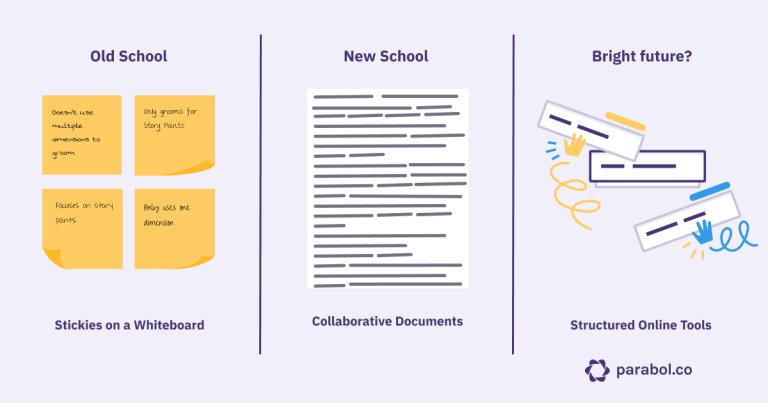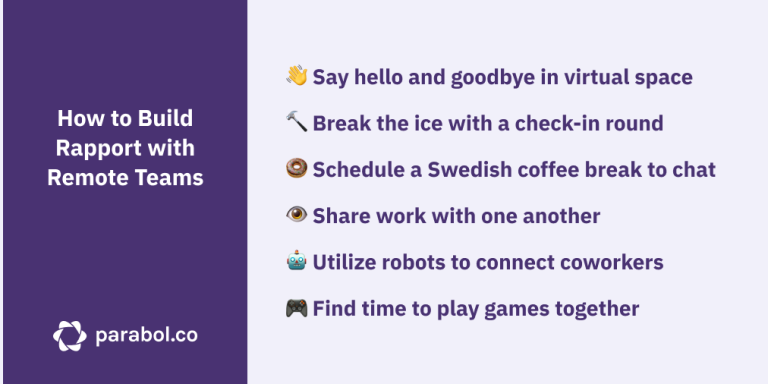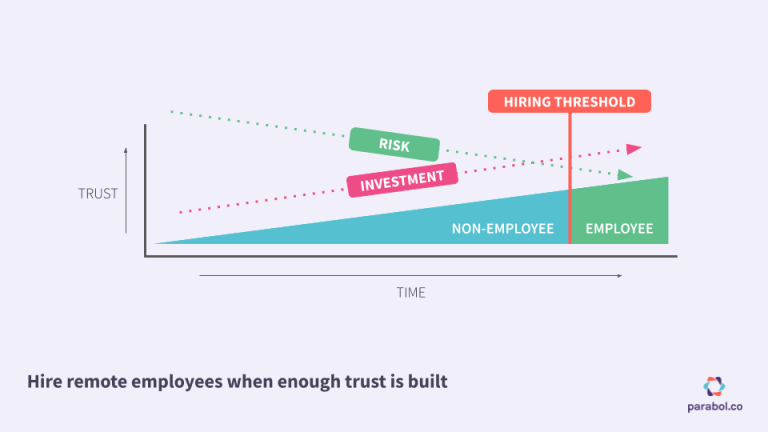How to Hire a Remote Team: Parabol’s 6 Step Process

Imagine giving your credit card, mobile phone, and laptop to somebody you’ve never met, and asking them to fill your shoes for a day—working your job, doing the shopping, and even picking up your kids from daycare. It’s risky. It’s frightening. It’s frightening because it’s risky.
It’s also not so far from the job employers need to do when hiring remotely. Somehow we’ve got to transform a person we’ve never met working from their couch to an employee we trust with the company credit card, social media account, or keys to our servers.
Hiring remote employees is as much about establishing mutual trust, as it is assessing for skill or cultural fitness.

What many hiring managers miss is trust is a two-way street: for highly sought-after skill sets, employers have to put forth nearly as much effort to prove themselves as trustworthy as candidates do. The hiring process must be intentionally designed for candidates and employers to meet each other under low trust conditions, invest in each other gradually, and de-risk the prospect of working together all the while providing means for evaluating candidates on other dimensions.
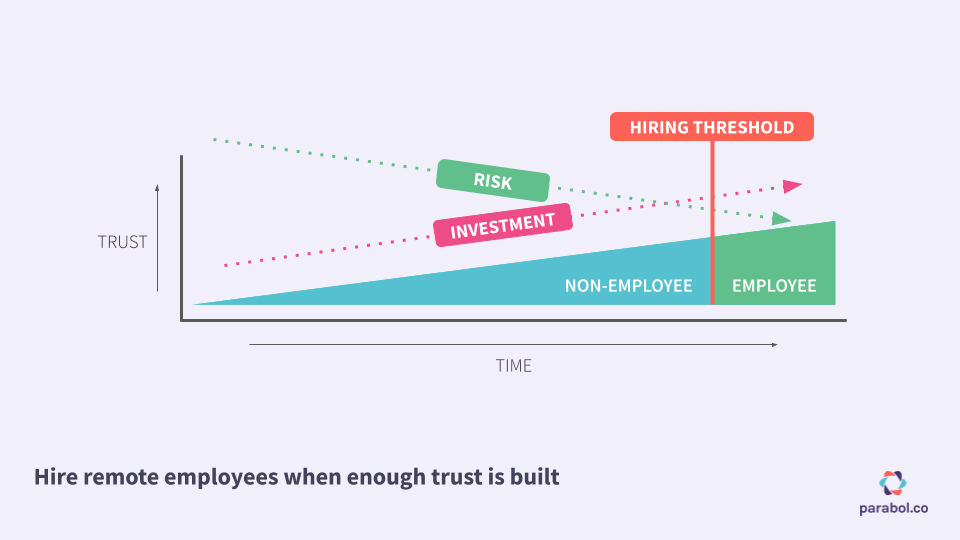
Thinking about the hiring process through a lens of progressively building makes the trigger for hiring simpler: a remote candidate becomes a remote employee when they are trusted enough.
Mapping Out the Remote Hiring Process
To hire remotely, we must build trust while checking to make sure they’re the right person for the job—all without ever meeting in person. Let’s lay out the big questions an employer should pursue while evaluating a candidate:
- Who will we evaluate?
- Are they eligible for work?
- Do they have the hard skills?
- Do they fit culturally?
- Do we trust them enough to hire them?
We can design a hiring process that pursues the answers to these questions, increasing our level of investment in a candidate—and theirs in us—along the way:
- Who will we evaluate?
➡ Application review - Are they eligible for work?
➡ Screening interview - Do they have the hard skills?
➡ Skills interview - Do they fit culturally?
➡ Cultural interview - Do we trust them enough to hire them?
➡ Contract-to-Hire evaluation
We can visualize these steps, correlating with increased trust and our hiring threshold like this:

Now all we’ve got to do is go and do it. Here are some things we’ve learned executing this process for ourselves at Parabol as a fully-distributed team.
6 Steps to Hiring a Remote Employee
Below we’ve documented how Parabol does hiring. We’ve also summarized this information into a presentation:
1. Make it easy for prospective remote employees to get started
Risk to remove: are they interested?
Most remote teams are part of the knowledge economy, and many knowledge economy jobs are extremely competitive for workers. In the first quarter of 2020, USNews reported Software Developers have an unemployment rate of only 1.6%. The best remote software developers aren’t just going to come knocking on your door. Often you have to proactively tap into the talent pool and source them yourselves.
If a great candidate is interested in your remote job offer, the last thing you want to put in front of them is too high a wall, too early in the hiring process. Your hiring process should be stringent but it should also be easy to get started.
In general, here are some things not to do:
- Require candidates to submit a long form
- Require candidates take an examination before being screened
- And even, require candidates to provide a formal resume or CV in lieu of a LinkedIn profile
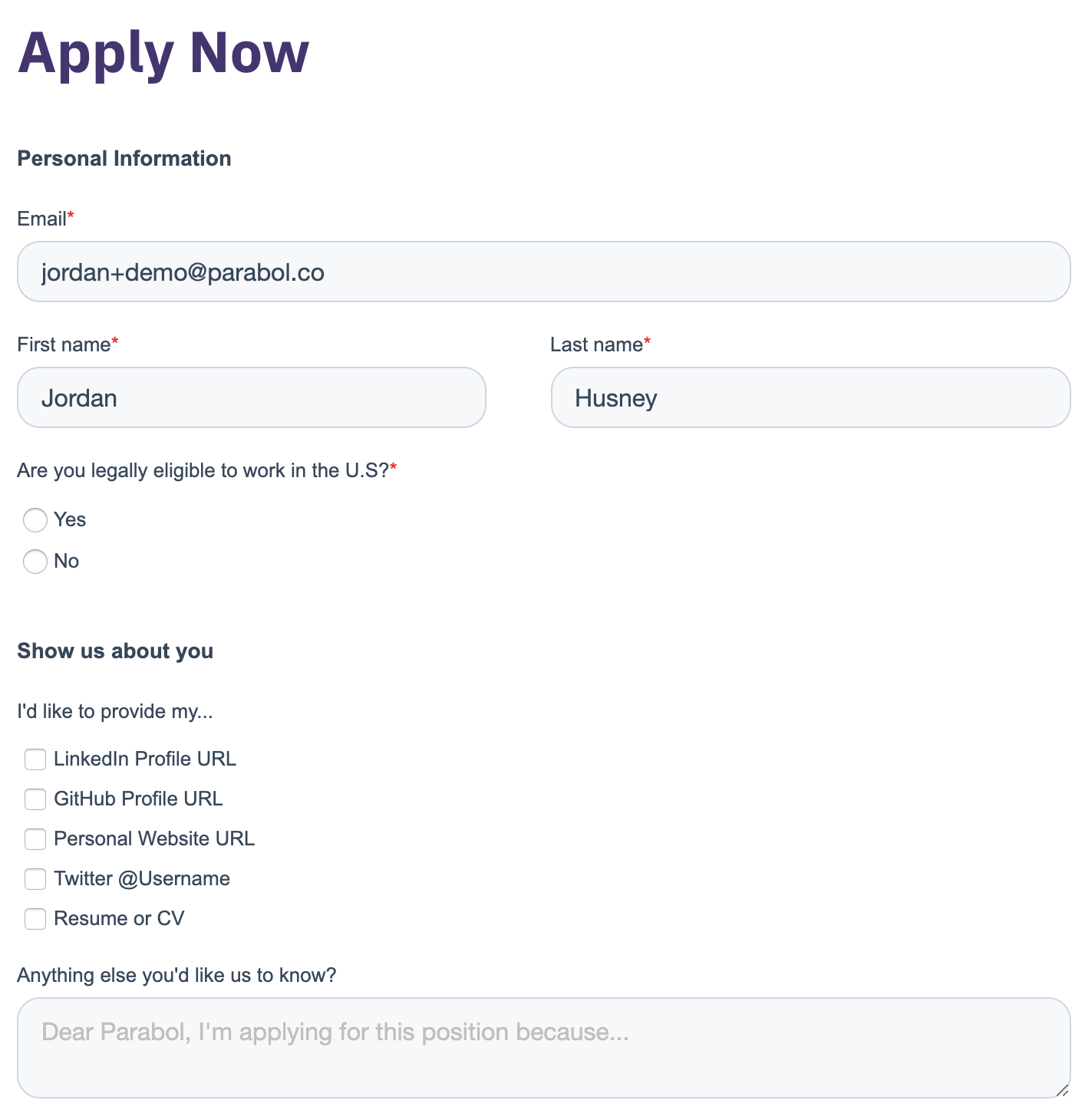
Parabol’s application form is short. For the majority of the roles we hire, it collects nothing more than a candidate’s basic contact information, work eligibility, and any links or materials the candidate feels are relevant for them to make an impression on us.
Not only does streamlining the information on an application make it easier for the candidate to apply, but it also makes the application review process that much easier for our hiring team when it comes time to evaluate all of the applications.
You’ll know when the front door to your hiring process is too simple: you’ll get too many low-quality applicants making submissions. The important thing to keep in mind is that you can always add additional requirements to increase applicant quality.
But if you start your process the other way, and throw up too many barriers too quickly you’ll never know who you’re missing.
2. Give additional calendar time judiciously
Risk to remove: are they worth additional calendar time?
If you’ve got a healthy inbound flow of candidates, you’ll have more applications than even your globally-distributed remote company has calendar time.
Giving your screening team a fixed budget (“spend no more than 8 hours per week screening candidates”) is a good tool for forcing decisions around who to include or exclude from moving on to a screening interview.
Spend an email, before spending time
When you’re intrigued by somebody but its not an enthusiastic yes that you have to meet them, a good muscle to build is to send an email asking for more detail before burning up calendar time.
Look for evidence of remote work aptitude online
Because so much of remote work revolves around writing and sharing digital assets, look for evidence of remote working skills. Some examples:
- A personal blog and/or social media interactions
- Public communications that’s clear, presents good character, and shows taste
- Collaboration on the internet (e.g. open-source development, political or non-profit projects, etc.)
- Prior remote work experience—full time, as a part-time contractor, or otherwise
Remove bias: hire on the slope, not y-intercept
Hiring a remote team has the advantage of including much wider geography in your candidate search than somebody who is locked to a locality. This means an employer can include a wider variety of backgrounds, including folks who have had relatively fewer opportunities to climb the career ladder. These candidates can make great employees but might fail to rank highly if assessed on traditional metrics such as “highest title achieved,” “years of experience,” or “quality of school and degree obtained.”
Rather, assess candidates on the steepness of their trajectory. Have they met challenges in their life and overcome them? Have they shared their experiences and outcomes online? Are they hungry and already leaning forward by trying harder to get your attention?
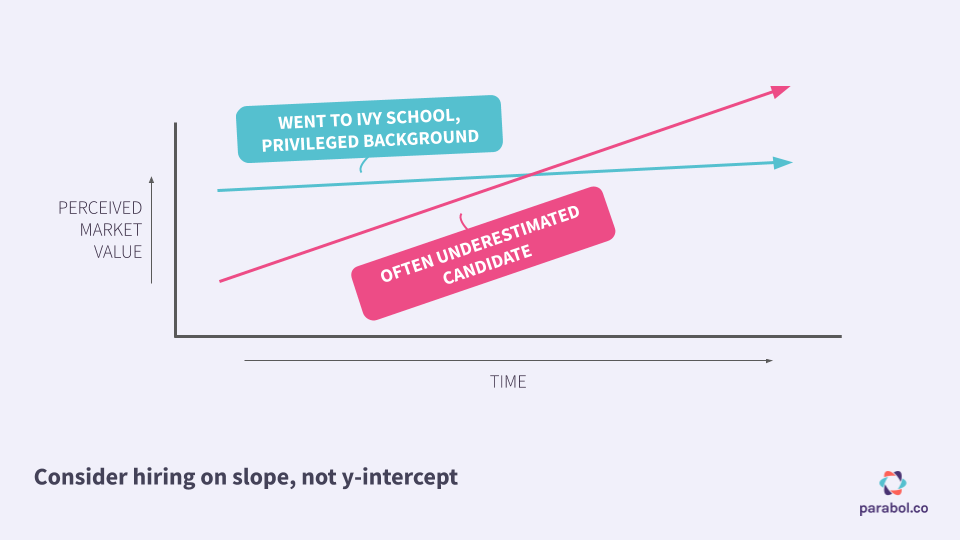
3. Screening applicants before spending your remote team’s time on low-quality candidates
Risk to remove: are they worth my team’s time?
So far the investment in the candidate can be measured by the number of minutes spent reviewing their application. Should a remote worker pass your screening interview you may not only be committing your time, but the time of your teammates in the next interview. Your goal in a screening interview is to arrange the agenda to reject a candidate as quickly as possible, primarily to save your—and the candidate’s—precious time, but also to minimize the risk of passing a candidate that will be rejected by your team down the road.
Ask the biggest question first
We schedule every screening interview for 30 minutes. Most screening interviews end around the 15-minute mark. Interviews start with our most important question first. If the answer is unsatisfactory, we take an early exit. We’ll use the time we save to update hiring records or perform a few application evaluations.
Our screening interview follows the following rough outline:
Hi, I’m so-and-so with Parabol. I fill [role description] here. We don’t want this first, short interview to feel like you’re getting grilled, rather we have just a couple of quick questions for you and with whatever time is left, we’d like you to ask me any questions about the role our company you might have. Does that sound ok?
[candidate gives consent]
Ok, here are the questions: compared to your previous roles, what would you like to do more of and less of in your next role? And why does Parabol feel like a good fit for you?
The big questions at the end let us assess several things in one go:
- Do they have an awareness of what energizes them?
- Does our role offer them what they are looking for?
- Are they enthusiastic about us? Did they do their homework?
- Do they communicate well?
If they don’t tick the boxes on the above questions, we can give them the option to ask a question or two and then end the interview. That sounds like:
I told you this first conversation would be quick! I’ll take the notes I’ve taken here back to our hiring committee and get back to you with next steps.
If spending more time with the candidate is warranted, we can use their own questions as jumping off points for our own inquiry.
Make the next step theirs
At the end of every remote interview, we always provide a moment to remind candidates where they are in the hiring process. We want them to know that our process is definite in terms of the number of conversations they’ll have and the maximum amount of time they’ll spend with us before we make a decision.
At the end of the screening interview, we always make the next step theirs and ask them to follow up. It sounds like this:
The next step is yours. Please write me an email with any questions that you didn’t get to ask today that you’d certainly like to have answered over the course of your interviews with us. That way we can tailor the remainder of the process to you. After you send me that email, I’ll forward it to the next person who’ll set up time with you. Sound good
Making this ask achieves a few important things. First, it tests a candidate’s enthusiasm for the role and their ability to follow up. Second, we learn exactly what a candidate expects from the interview process. Third and lastly, this email stitches together our interview process and enriches the data in our hiring CRM without any unnecessary automations.
4. Evaluate skills of remote workers through relevant, realistic experiences
Risk to remove: do they have the expertise?
For decades, skill evaluation has been a hotbed of experimentation. Candidates have been subjected to innumerable brain teasers and whiteboarding exercises. After relying on variations on this style of skill evaluation for more than a decade, Laszlo Bock, the former Google senior V.P. of People Operations, shared Google had abandoned the approach stating brainteasers are “a complete waste of time,” and “don’t predict anything” when it comes to job success.
Some 7 years later, these practices are still common and have led to popular backlash, with crowdsourced sites such as Hiring Without Whiteboards keeping an up-to-date list of companies who don’t use them to evaluate candidates.
Keeping it real
So without puzzles and whiteboarding exercises, how does Parabol evaluate a candidate’s skills? We share real data from our company with the candidate—much of which is available online. It’s as close a proxy for working with a prospect without actually having hired them. If it’s a marketing role, we’ll show them funnel data. If it’s a sales candidate, we’ll give them transcripts from real prospects, if it’s a developer, we’ll review our source code, etc.
2 months, 2 weeks
During their second interview, candidates are asked to look critically at Parabol data and ask us questions in order to create their own remote onboarding plan and scope out about 2 months of work. From the questions candidates ask, we get a sense of their depth of skill, how they think and communicate, and prioritize what to learn in a new situation. We’ve found no better initial activity to evaluate who’s ready to work in the 21st century than this one. And, while we learn a lot about the candidate, candidates get a sense of our strategy and direction, acumen, and what we’re like to work with.
When the interview is nearing its end, we give candidates their final assignment: we ask them to prioritize the list of things they’d like to do in their first 2 months down to 3–5 things. Next, we ask them to identify the first 3–5 things they’d get done in their first two weeks and send their “2 month/2 week” plan to us in an email. We share with the candidate this plan will be used in the final interview phase, and as a component of their actual onboarding plan if they should start with us full-time.
Note: credit should be given where credit is due: we learned about the simple 2 month, 2 week, 2 days goal setting exercise from NOBL and use it often within our company, including this process.
5. Evaluate whether prospective employees fit into your culture
Risk to remove: do they want to build the kind of company we’re trying to build?
Evaluating a candidate’s alignment to our values and company culture is just as important as sizing up their hard skills.
The difference between the two interviews is an increase in commitment from our hiring team. While it’s common for the skill assessment to be conducted by 1–2 team members, the cultural interview will have a representative from every team present.
Candidates are evaluated on Parabol’s 3 core values:

Some organizations use ‘culture fit’ as a way to reinforce building a culture that’s monolithic in every way, intentionally or unintentionally resulting in a culture that values sameness derived often from the straight-white-male ideal, ending up with a team over indexed on straight white men and the straight-white-male perspective.
Parabol aspires to embrace Generative Difference—a term coined by Dr. Dara Blumenthal, PhD, to prioritize growing a team that includes and benefits from a variety of origin stories, experiences, and expressions with enough commonality among our values to make communication and collaboration possible. To that end, our culture interview questions are geared towards asking about values rather than specific experiences.
Before the meeting, Parabol team members are invited to a shared collaborative document containing up-to-date questions to ask a candidate. At the bottom of the document is an evaluation instrument. Here we’re measuring how much we trust this candidate to become a member of our culture. At the same time, we’re reaffirming as a team how much we trust each other to pick who can join us.

Check for empathy
We believe the ability to step outside of oneself and imagine how another person might see a situation is crucial to building a smoothly operating remote team. We also think this quality allows us to provide great customer service, and design great products. During the See All Sides section of our culture-fit interview, we lead off by asking these questions:
Can you think of a time when you last lost your cool? If you feel comfortable, would you share what that moment was all about?
What most candidates seem to assume is that we’re interested in discovering how they resolve conflict. After they’ve given us the facts and their interpretation of events, they’ll often begin to explain how they worked it out with the other party. We’ll kindly interrupt them to ask:
Now, if we were to ask the other person what their version of this story would be, what would it sound like?
If they can give us a credible and differing interpretation, an evaluator may score them highly on the Seeing All Sides interview evaluation.
This said, there we are many caveats and flaws in our approach. While we are persistently revising our cultural interview questions to be simpler to ask and be a better evaluation of what we’re looking for, we’re aware that “absence of evidence is not evidence of absence,” and not getting a clear result from our line of questioning doesn’t necessarily mean that somebody wouldn’t be a good fit for our company. It does, however, show us what to be on the lookout for if we choose to advance that applicant to our final phase.
6. Give your team & potential new hires a hands-on experience with contract-to-hire
Risk to remove: do we trust them enough to hire them?
After the interviews are over, most traditional hiring processes would force a team to decide: do we wish to extend an offer to this candidate or not? Our process differs by asking our team a different question:
Do we want to put some of our company’s money and more of our team’s time to try working alongside this candidate?
If yes, we extend a part-time contract we call a Batting Practice in order to provide us, and the candidate, the experience of doing real work together.
Pay a fair-market rate for remote roles
Setting up a part-time contract may seem like a lot of effort, but it is a lot less effort than hiring a candidate that doesn’t fit in your organization. For each position, we allocate a monthly budget against a maximum number of candidates to trial for a position. This limit forces us to think carefully as to whether or not we want to continue to invest in a candidate.
We are also firm about not asking a candidate to do any work for free, or much beneath a rate (if at all) they could solicit from the open market. We offer every remote job seeker who gets to this stage a fair price because we believe it’s the moral thing to do, and it properly aligns incentives: we treat candidates like we’ve put money behind them, and candidates give us their best work.
Flex the duration to fit circumstance of the candidate
Not all candidates have an equal amount of free time in order to take on additional part-time work. Some candidates—most perhaps—are already employed full time. Others have responsibilities in their evenings that make finding the time for additional work scarce.
We accommodate different types of candidates while keeping it fair by setting a fixed amount of effort we expect a task to take and then flexing the duration of the contract. For example, we expect the tasks identified in a Parabol Batting Practice to take about 20 hours. We offer the candidate a 2 to 4 week term in order to chip away at these 20 hours.
Partially onboard prospective new team members
To determine what to work on, we present candidates options for their own 2-week, 2-month onboarding plan—occasionally adding a few of our own.
Imagine a promising marketing candidate concludes after seeing our marketing data that we need to focus on a post-initial signup retention campaign. An option offered to them in the Batting Practice may be to deliver a campaign that achieves exactly that.
Should they choose to accept their mission, we’ll give them a parabol.co email address, invite them to Slack, share data, and access to any tools they need to get the job done. We give them a parabol.co email address for ease of security control: Access to our tools are governed by single-sign on. If a candidate doesn’t work out, we have one place we can go to revoke access.
End the evaluation in a way consistent with your culture
At the end of a Batting Practice, we – our internal team and the candidate – schedule time to review the work performed and run a retrospective on what went well and what could have gone better.
We learn as a team, and it provides a clear moment to collect final evaluations from hiring evaluators. Any doubts we had about the candidate before the Batting Practice are resolved and it must be a unanimous decision in order to extend an offer to hire.
Cohort to scale your remote hiring efforts
When we’ve shared our Batting Practice methodology with other remote hiring professionals, we often hear, “this sounds great but what could never do this, trial-to-hire is too difficult to scale.” To which we say:
What is more resource intensive? Hiring slowly or hiring several of the wrong employees?
Certainly, trialing before hiring employees is resource intensive but there are ways to reduce its cost. Aligning the start dates of trial-to-hire employees to onboard them at once is an effective means of reducing some of the lift. Also, asking recently hired employees to lead the non-compliance side of onboarding (e.g. tool or data walkthroughs) is a great way to distribute load and get more of our remote workforce involved in hiring.
Final thoughts
Our remote hiring process is designed to:
- Gradually build mutual trust
- Progressively increase investment in promising candidates
- Evaluate candidates on real data (not hypotheticals)
- Spend as few resources on candidates we won’t hire as possible
For candidates hired through this process the net result are folks who are ready to work. Much of the items usually done during the remote onboarding process have already been completed.
Is this process perfect? Heck no. As with the entirety of our product and company, this process is always a work in progress.
If you decide to adapt portions of our process for your own remote recruiting, we’d be honored if you’d reach out and let us know what’s working, what could be better, and what you’ve changed.
I initially shared these thoughts at the Change at Work conference by NOBL, here’s the full video and transcript.






